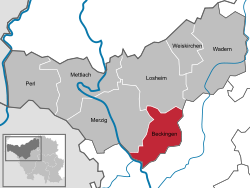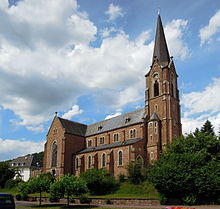Merzig-Wadern is a Kreis (district) in the northwest of the Saarland, Germany. Neighboring districts are Trier-Saarburg, Sankt Wendel, Saarlouis, the French département Moselle, and Luxembourg.
Sankt Wendel is a Kreis (district) in the north of the Saarland, Germany. Neighboring districts are Trier-Saarburg, Birkenfeld, Kusel, Neunkirchen, Saarlouis, and Merzig-Wadern.
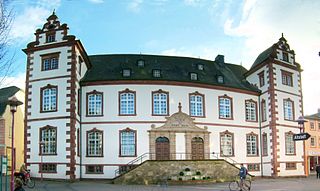
Merzig is a town in Saarland, Germany. It is the capital of the district Merzig-Wadern, with about 30,000 inhabitants in 17 municipalities on 108 km². It is situated on the river Saar, approx. 35 km south of Trier, and 35 km northwest of Saarbrücken.

Beckingen is a municipality in the Merzig-Wadern district in Saarland, Germany. It is situated on the river Saar, approximately 7 km southeast of Merzig and 30 km northwest of Saarbrücken. It was created on January 1, 1974 as part of the territorial and administrative reform of the villages Beckingen, Düppenweiler, Erbringen, Hargarten, Hausstadt, Honzrath, Oppen, Reimsbach and Saarfels.

Losheim am See is a municipality in the district Merzig-Wadern, in Saarland, Germany. It is situated on the southern ridge of the Hunsrück, approximately 10 kilometers northeast of Merzig, and 35 kilometers northwest of Saarbrücken. In 1974 a reservoir was created in the north of Losheim that has become a popular spot for recreational activities such as hiking and swimming.

Rehlingen-Siersburg is a municipality in the district of Saarlouis, in Saarland, Germany. It is situated on the river Saar, approx. 8 km northwest of Saarlouis, and 30 km northwest of Saarbrücken.

Saint Leudwinus, Count of Treves founded an abbey in Mettlach. He was Archbishop of Treves and Laon. As patron saint of the Mettlach parish, his relics are carried through the town by procession at the annual Pentecost celebration. His feast day is September 23. He was the son of Saint Warinus, the paternal grandson of Saint Sigrada, and nephew of Saint Leodegarius.

Saarland Police is a state law-enforcement agency in Saarland, Germany. It is subordinated to the Saar Ministry of the Interior, Urban Development and Sports.

Borg is a German village in the municipality of Perl, Saarland. It is located 5 km north east of Perl and 11 km south west of Nennig on the River Mosel. It lies at a height of 355 m and has a population of 370. The nearby Roman Villa Borg is one of the Saarland's most important archaeological sites.

The Saarbrücken–Trier railway, known in German as the Saarstrecke in the German states of Rhineland-Palatinate and Saarland. It connects Saarbrücken and Trier. It was opened in 1858 and 1860 and is one of the oldest railways in Germany.

The Fischbach Valley Railway is a railway line in the German state of the Saarland that runs from Saarbrücken along the Fischbache, which flows into the Saar in Saarbrücken, to Wemmetsweiler. Since the opening of the Wemmetsweiler curve in 2003, the line branches west to Lebach as the Prims Valley Railway (Primstalbahn) and east to Neunkirchen.
The Saarbrücken–Sarreguemines railway is a two-track main line railway, running from Saarbrücken in the German state of the Saarland to Sarreguemines just over the border in France. The route runs along the Saar to Sarreguemines.
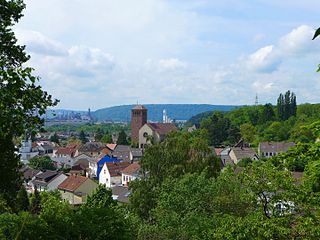
Diefflen is a district of Dillingen/Saar in the district of Saarlouis (Saarland) and has about 4700 inhabitants. It is located on the lower Prims, a tributary of the Saar. Since its foundation in the High Middle Ages Diefflen was historically linked to the villages of the former "Hochgericht Nalbacher Tal". This association was broken when Diefflen was incorporated into the city of Dillingen/Saar in 1969.

The so-called Saardom in Dillingen/Saar is one of the largest sacred buildings in Saarland. It is the parish church of the parish of St Sacrament. The parish belongs to the parish community of the Holy Sacrament, St John the Baptist in Dillingen, St Joseph and St Wendelin in Diefflen, St Maximin in Pachten, and St Mary consolation of the saddeneds on the Pachtener Heide. The church belongs to the Roman Catholic Diocese of Trier. The feast of dedication is the Solemnity of the Most Holy Body and Blood of Christ.
Irmgard Fuest was a Saarland politician of the CVP / CDU and lawyer. She completed her legal traineeship at the Court of Appeals and passed her second state examination in 1931, then she worked as a judge at Brühl District Court and as a lawyer in Cologne. In 1935, she founded a law firm in Neunkirchen together with her husband Josef Fuest. She was the first woman to become a judicial councilor in the Federal Republic.

Schwarzenholz is the second largest district of the municipality of Saarwellingen in Saarland, Germany.

Ort der Vielfalt is an initiative launched in 2007 by the Federal Ministry of Family Affairs, Senior Citizens, Women and Youth, the Federal Ministry of the Interior and the Federal Government Commissioner for Migration, Refugees and Integration with the aim of strengthening the commitment of communities, towns and districts in Germany to cultural diversity. This initiative comes from the federal programmes Vielfalt tut gut. Jugend für Vielfalt, Toleranz und Demokratie and kompetent. für Demokratie – Beratungsnetzwerke gegen Rechtsextremismus. Since 1 January 2011, the Federal Programme Toleranz fördern – Kompetenz stärken has again been continuing the two federal programmes under one roof.
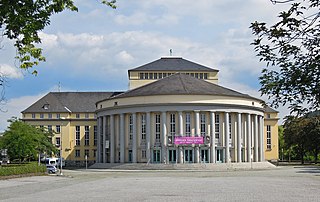
Theater Saarbrücken, officially Saarländisches Staatstheater since 1971, is the state theatre of Saarland in its capital Saarbrücken, Germany. It has several divisions and offers annually around 30 new productions in around 700 events for more than 200,000 people. Its venues are Großes Haus, Alte Feuerwache, Congresshalle and sparte4. While theatre in Saarbrücken has a long history, the present main venue was completed in 1938, with plans commissioned by the Nazi regime.

The Saarschleife, also known as the Great Bend in the Saar at Mettlach, is a water gap carved by the Saar River through a quartzite layer and today one of the most well-known tourist attractions of the Saarland.

